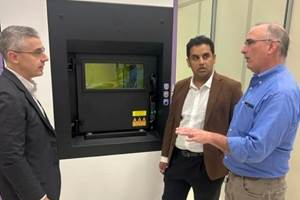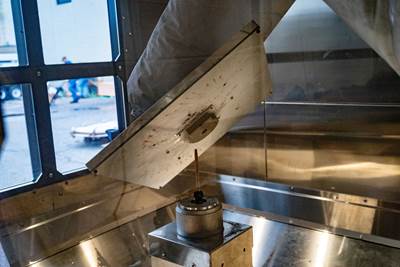This Year I Have Seen a Lot of AM for the Military — What Is Going On?
Audience members have similar questions. What is the Department of Defense’s interest in making hardware via 3D printing over conventional methods? Here are three manufacturing concerns that are particular to the military.
In my visits to additive manufacturing providers throughout this year (2024), it has been hard to miss the extent to which the U.S. Department of Defense is exploring AM and expecting to use it as an aid to military response and readiness.
Indeed, I could call this the year of the submarine. The U.S. Navy’s efforts to upgrade submarines and expand submarine production are evident in projects additive manufacturers have underway. Travels I made this year in three different time zones, to Pittsburgh, Huntsville and Denver, all included stops at companies I found applying metal AM to make submarine components for the DOD. (HAMR Industries, Quadrus and Big Metal Additive, respectively, were making submarine parts via cold spray additive, laser powder bed fusion and directed energy deposition).
It's not just submarines, though. Projectiles and the hardware for unmanned aerial systems are other areas of AM activity for the military. This year, it has seemed to be almost universally true: If I visit a metal AM part provider, regardless of the metal AM process, I find they are doing some work for the military. Previous years have not shown this theme.
Why the DOD’s increased pursuit of the promise of AM? The political and geopolitical drivers of this activity are beyond what I know. Manufacturing is the lens through which I report on the world, and the questions I can see and address through this lens are more focused yet similarly compelling. They relate to the nature of this promise, namely: Among manufacturing processes, why is additive manufacturing in particular valuable for military part production?
From our audience members, that line of questioning came out starkly in response to our coverage of Big Metal Additive’s use of DED to make projectile housings for the U.S. Navy. See our video about this work. These projectile housings are usually forged — and many wondered, isn’t forging in fact the best way to make them? That is, hammer out a lot of these housings quickly using dedicated dies, rather than digitally printing each one. Metal AM is seemingly for short-run sophisticated parts like high-end aircraft components and implants, not artillery shells. Audience members asked: Why lean into metal 3D printing to make military parts such as this?
The answers challenge assumptions about production and additive’s role in it, and also hinge on some of the special manufacturing opportunities unique to the military’s needs. Here are three points about AM that span across the military’s hardware needs, from those projectile housings to submarines to unmanned aerial vehicles:
1. Additive manufacturing brings cost savings and new performance to existing systems.
Submarine components originally built through assembly, seen here made with fewer welds via additive manufacturing. Quadrus Corp. produced these parts, as well as the hypersonic component seen below. A future opportunity for the sub parts is to redesign them for AM to simplify production and reduce lead time even further.
Another defense-related component produced by Quadrus: a tungsten rhenium throat insert for a solid-fuel missile. AM will reduce the lead time for making this part by months. This photo and the one above taken during a visit to Quadrus; read our report.
It is the nature of military systems that the armament invented during one generation will be put to use in a different generation. Capable systems do not become antiquated if they are sustained, and sustainment is part of the military’s use and management of its systems. (Manufacturers understand this well — the most precise machine tools from decades ago can be refurbished into precise machines today.) However, additive brings something new to sustainment: the chance to produce replacement parts as they are needed, combined with the chance to improve the part’s cost or capabilities through 3D printing. Development work around parts for existing submarines pursues these advantages. Something similar is true of hypersonic engine components made additively. (See photos on this page.)
2. For the military, responsiveness is as important as production rate.
Forge and foundry capacity in the U.S. is limited, and this capacity cannot be transitioned quickly into making a different product — even though forging or casting may ultimately be the most productive way to make the part. In this, the military application is not so different from commercial production. A commercial manufacturer might rely on additive for the sake of faster delivery, while the military uses it to more quickly obtain the equipment to respond to a mission need.
A related point: Just because AM does the job does not mean a process like forging ceases to do it. Quick response might mean getting the parts the military needs through additive while waiting for forging to tool up and thereby catch up, starting at that point to produce the parts more rapidly.
3. Military systems can outlive tooling and suppliers.
It is also the nature of military hardware that we can go a long time without needing it. (Indeed, this is to be hoped for.) During this time, the suppliers for a forged or cast part might have gone out of business, and the physical tooling needed to make the part might have been lost. As a toolingless approach to manufacturing, additive manufacturing can span these long interludes. No physical tool has to be preserved and accounted for. And in the future, if the part has to be made by a supplier different from the original, the shift can be made simply by sending the digital file.
Beehive Industries is creating a new engine for existing unmanned aerial systems that is built in one location and made primarily from just five additively manufactured components. A demonstrator engine from the company is seen here in a test apparatus (image courtesy Beehive). Read the report of our visit with Beehive.
Related: These freedoms across time translate to similar freedom across distance. With no tooling to transport, part files can be distributed geographically — even to the field and to 3D printers at sea — for manufacturing near to the point of need.
An example that illustrates all three points above involves Beehive Industries: The company is using additive manufacturing to make small aerial engines that replace previous engines, and previous suppliers and supply chains, with engines that are made with considerably fewer parts and steps, and allow the craft they power to realize performance improvements. In the military case for additive, all these gains are valuable at once. That is, flexibility meets productivity, and the capabilities of legacy systems are as important as new designs.
Related Content
Big Metal Additive: The Difference Between a Shape and a Part Is Quality
Preparing to scale directed energy deposition to ongoing full production is not a technological challenge: DED is ready. But it is an organizational challenge, says the company founder. Here is what it means to implement a quality system.
Read More3D Printed Titanium Replaces Aluminum for Unmanned Aircraft Wing Splice: The Cool Parts Show #72
Rapid Plasma Deposition produces the near-net-shape preform for a newly designed wing splice for remotely piloted aircraft from General Atomics. The Cool Parts Show visits Norsk Titanium, where this part is made.
Read MoreNew Zeda Additive Manufacturing Factory in Ohio Will Serve Medical, Military and Aerospace Production
Site providing laser powder bed fusion as well as machining and other postprocessing will open in late 2023, and will employ over 100. Chief technology officer Greg Morris sees economic and personnel advantages of serving different markets from a single AM facility.
Read MoreBeehive Industries Is Going Big on Small-Scale Engines Made Through Additive Manufacturing
Backed by decades of experience in both aviation and additive, the company is now laser-focused on a single goal: developing, proving and scaling production of engines providing 5,000 lbs of thrust or less.
Read MoreRead Next
Quadrus: Powder Management Tactics for Tungsten Rhenium and Other AM Alloys
The expert in additive manufacturing of high-value parts for the Defense Department often must change from one exotic material to another in its powder bed machines. Cleaning is a core competency. Here are lessons of this company’s system for working with an ever-changing mix of 3D printed alloys.
Read MoreThe Cold Spray Solution to the Casting, Forging Supply Chains
Startup HAMR Industries performs additive manufacturing work at Neighborhood 91 that provides an alternative to traditional casting and forging. Success so far has led to redefining the limits of its additive equipment.
Read MoreBig Metal Additive: The Difference Between a Shape and a Part Is Quality
Preparing to scale directed energy deposition to ongoing full production is not a technological challenge: DED is ready. But it is an organizational challenge, says the company founder. Here is what it means to implement a quality system.
Read More




















